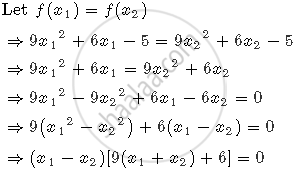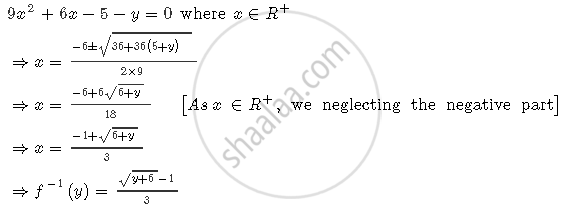Advertisements
Advertisements
Question
Consider f: `R_+ -> [-5, oo]` given by `f(x) = 9x^2 + 6x - 5`. Show that f is invertible with `f^(-1) (y) ((sqrt(y + 6)-1)/3)`
Hence Find
1) `f^(-1)(10)`
2) y if `f^(-1) (y) = 4/3`
where R+ is the set of all non-negative real numbers.
Solution
f: `R_+ -> [-5, oo]` given by `f(x) = 9x^2 + 6x - 5`
To show: f is one-one and onto.
Let us assume that f is not one-one.
Therefore there exist two or more numbers for which images are same.
For x1, x2 ∈ R+ and x1 ≠ x2

Since x1 and x2 are positive,
9(x1 + x2) + 6 > 0
∴ x1 − x2 = 0⇒ x1 = x2
Therefore, it contradicts our assumption.
Hence the function f is one-one.
Now, let is prove that f is onto.
A function f : X → Y is onto if for every y ∈ Y, there exist a pre-image in X.
f(x) = 9x2 + 6x −5
= 9x2 + 6x + 1 - 6
=(3x + 1)2 - 6
Now, for all x ∈ R+ or [0,∞), f(x) ∈ [−5, ∞)
∴ Range = co-domain.
Hence, f is onto.
Therefore, function f is invertible.
Now, let y = 9x2 + 6x − 5

1) `f^(-1) (10) = (sqrt(10+6)-1)/3 = (4-1)/3 = 1`
2) `f^(-1) (y) = 4/3`
`:.(sqrt(y + 6) -1)/3 = 4/3`
`=> sqrt(y + 6)-1 = 4`
`=> sqrt(y+6) = 5`
`=> y + 6 = 25`
=> y = 19
APPEARS IN
RELATED QUESTIONS
Let f, g and h be functions from R to R. Show that
`(f + g)oh = foh + goh`
`(f.g)oh = (foh).(goh)`
Find gof and fog, if f(x) = |x| and g(x) = |5x - 2|
Find gof and fog, if `f(x) = 8x^3` and `g(x) = x^(1/3)`
State with reason whether following functions have inverse
f: {1, 2, 3, 4} → {10} with
f = {(1, 10), (2, 10), (3, 10), (4, 10)}
Consider f: R → R given by f(x) = 4x + 3. Show that f is invertible. Find the inverse of f.
Consider f: R+ → [4, ∞) given by f(x) = x2 + 4. Show that f is invertible with the inverse f−1 of given f by `f^(-1) (y) = sqrt(y - 4)` where R+ is the set of all non-negative real numbers.
Consider f: R+ → [−5, ∞) given by f(x) = 9x2 + 6x − 5. Show that f is invertible with `f^(-1)(y) = ((sqrt(y +6) - 1)/3)`
Let f: X → Y be an invertible function. Show that f has unique inverse. (Hint: suppose g1 and g2 are two inverses of f. Then for all y ∈ Y, fog1(y) = IY(y) = fog2(y). Use one-one ness of f).
Consider f: {1, 2, 3} → {a, b, c} given by f(1) = a, f(2) = b and f(3) = c. Find f−1 and show that (f−1)−1 = f.
If f: R → R be given by `f(x) = (3 - x^3)^(1/3)` , then fof(x) is
(A) `1/(x^3)`
(B) x3
(C) x
(D) (3 − x3)
Let f: W → W be defined as f(n) = n − 1, if is odd and f(n) = n + 1, if n is even. Show that f is invertible. Find the inverse of f. Here, W is the set of all whole numbers.
Is g = {(1, 1), (2, 3), (3, 5), (4, 7)} a function? If g is described by g (x) = αx + β, then what value should be assigned to α and β
Let f: A → B and g: B → C be the bijective functions. Then (g o f)–1 is ______.
Let f: N → R be the function defined by f(x) = `(2x - 1)/2` and g: Q → R be another function defined by g(x) = x + 2. Then (g o f) `3/2` is ______.
Let f = {(1, 2), (3, 5), (4, 1) and g = {(2, 3), (5, 1), (1, 3)}. Then g o f = ______ and f o g = ______.
If f : R → R, g : R → R and h : R → R is such that f(x) = x2, g(x) = tanx and h(x) = logx, then the value of [ho(gof)](x), if x = `sqrtpi/2` will be ____________.
If f : R → R, g : R → R and h : R → R are such that f(x) = x2, g(x) = tan x and h(x) = log x, then the value of (go(foh)) (x), if x = 1 will be ____________.
Let f : R → R be the functions defined by f(x) = x3 + 5. Then f-1(x) is ____________.
The inverse of the function `"y" = (10^"x" - 10^-"x")/(10^"x" + 10^-"x")` is ____________.
If f is an invertible function defined as f(x) `= (3"x" - 4)/5,` then f-1(x) is ____________.
A general election of Lok Sabha is a gigantic exercise. About 911 million people were eligible to vote and voter turnout was about 67%, the highest ever

Let I be the set of all citizens of India who were eligible to exercise their voting right in the general election held in 2019. A relation ‘R’ is defined on I as follows:
R = {(V1, V2) ∶ V1, V2 ∈ I and both use their voting right in the general election - 2019}
- Two neighbors X and Y ∈ I. X exercised his voting right while Y did not cast her vote in a general election - 2019. Which of the following is true?
The domain of definition of f(x) = log x2 – x + 1) (2x2 – 7x + 9) is:-
Domain of the function defined by `f(x) = 1/sqrt(sin^2 - x) log_10 (cos^-1 x)` is:-
Let A = `{3/5}` and B = `{7/5}` Let f: A → B: f(x) = `(7x + 4)/(5x - 3)` and g:B → A: g(y) = `(3y + 4)/(5y - 7)` then (gof) is equal to
If f(x) = [4 – (x – 7)3]1/5 is a real invertible function, then find f–1(x).
